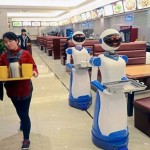 The past few years have seen no shortage of discussion around talent, and I was talking to someone only this week about creative ways startups can grow.
The past few years have seen no shortage of discussion around talent, and I was talking to someone only this week about creative ways startups can grow.
Traditionally, these kind of discussions have included approaches such as crowdsourcing or the gig economy that have allowed organizations to take an agile approach to their workforce.
Whether the workforce is predominantly employed and on-site or flexible and remote, both approaches assume that the workforce will remain very much human.
A new automated workforce
China however is taking an altogether different approach, and is laying the groundwork for a revolution that will see millions of low paid jobs becoming automated.
The move was revealed by vice president Li Yuanchao via the country’s primary robotics conference in Beijing where he outlined the important role robots will play in the future of the country.
Central to this push is the latest wave of industrial robots that will be deployed in the manufacturing sector. With the country facing pressure to maintain its low cost competitive advantage, it seems inevitable that automation will be a major factor in attempts to remain ahead of the pack.
China is already the largest importer of robots, and estimates suggest it will account for approximately 1/3 of all installed industrial robots within a few years.
The rise of the robot
Despite this apparent scale however, the robot to worker ratio in the country remains significantly lower than in most other industrially advanced nations, so there would appear to be huge scope for expansion.
Such a move is already under way, with the Made in China 2025 project designed to ensure the country remains a manufacturing superpower by that time. Central to the project is the addition of intelligence to their manufacturing base.
An example of what could be achieved was highlighted last year with the creation of a new plant in the Dongguan manufacturing hub in the south of the country which will be staffed almost exclusively by robots.
Initially about 1,000 robots will be used at the factory of the Shenzhen Evenwin Precision Technology Co, which produces components for mobile phones.
“The use of industrial robots will help the company to reduce the number of frontline workers by at least 90 percent,” said Chen Xingqi, the chairman of the company’s board. “When all the 1,000 industrial robots are put into operation in the coming months, we will only need to recruit fewer than 200 software technicians and management personnel.”
It is undoubtedly going to be a huge job to grow both the volume of robots available in the country, but also their capabilities. It will require a substantial amount of work deciphering which jobs are suitable for automation, and how man and machine will work well together.
Domestic robotics
It will also require the continued growth of the domestic robotics manufacturing market in China, with companies like Siasun leading the way.
They’re working on a range of robots to help factories automate a higher proportion of their work. Their range of robots also includes models for the shipping and utility industries.
An increasing focus for manufacturers is to develop robots with advanced sensing capabilities, and of course the ability to work effectively and safely alongside humans.
It’s a challenge that the country hopes will attract the brightest minds in the field to take it on.
“China would like to welcome robot experts and entrepreneurs from all over the world to communicate and co?perate with us, in order to push forward the development of robot technology and industry,” Vice President Li says.
The need for a Chief Robotics Officer
With robots and other automated services becoming an increasing presence in the workplace, it begs the question of how long before this automated workforce is represented at board level.
A study last year by Myria Research suggested that 60% of companies will have a Chief Robotics Officer by 2025. They believe that in sectors where robotics and automation will play a significant role, such as farming, logistics and healthcare, the CRO will have a similar status to that of the CIO today within a few years.
“The CROs (and their teams) will be at the forefront of technology, to translate technology fluency into clear business advantages, and to maintain RIOS capabilities that are intimately linked to customer-facing activities, and ultimately, to company performance,” they say.
With automation only likely to increase in importance in the coming years, it seems inevitable that strategic representation will be required for people with skills in the field.
There have been no shortage of proclamations about new C suite roles in the past few years, but I would not be surprised to see the evolution of a robotics executive be one that sticks.
Maybe this should be a position filled by a robot?